Transcription of D i s s o c i a t i o n - Beacon House
1 F e b r u A R Y 2 0 2 0 Dissociationin children and teensAuthorDr Shoshanah Lyons, Specialist Clinical Psychologist @BeaconHouseTeamFOLLOW US:2020 Beacon House Therapeutic Services & Trauma Team All Rights ReservedWhat dissociation is and why it develops How to spot dissociation How to help a dissociative child How to find out moreThis resource is for any adult supporting, teaching, caring for orparenting a child who uses dissociation as a way of coping withoverwhelming experience. We aim to share with you some keyideas about: 2020 Beacon House Therapeutic Services & Trauma Team All Rights Reserved- 2 -Children who have survived experiences which were frightening, or experiences where theirbasic needs for survival and connection were not met, are vulnerable to dissociating as a wayof coping.
2 Who is this resource for?What is dissociation?Dissociation in children and teens | February 2020 Dissociation is a survival mechanism, andone that is so often overlooked intraumatised children. Imagine a child whois being physically abused by a parent inthat moment of violence they cannot fightback and nor can they physically run away,but they can escape in their mind. Allhumans have a natural ability to mentally leave the room when their trauma isutterly unbearable. Babies and toddlersdissociate when they are in danger or whentheir experience is intolerable.
3 Dissociationis vital for infants and children who aresuffering frightening things, it enablesthem to keep going in the face ofoverwhelming Beacon House Therapeutic Services & Trauma Team All Rights Reserved- 3 -A child often continues to dissociate even when they are no longer in danger. Their brain cannotturn the coping strategy off. Because memories are fragmented into lots of little pieces bydissociation, children can often have a flashback to a memory, a feeling, a behaviour or a physicalpain with no understanding of why or what triggered it.
4 This can feel disorienting and confusingfor the child all they know is that they feel in immediate danger. The more frightening the child s traumas were, the more likely they are to dissociate; and children in ongoing danger will develop more and more sophisticated ways to dissociate. What is dissociation? (cont)Dissociation in children and teens | February 2020 Dissociation is a separation or disconnection betweenthoughts, feelings and behaviours; and a separationbetween the mind and body. It is the mind s way ofputting unbearable experiences and memories intodifferent compartments.
5 For example a child may remember a traumatic eventbut have no feelings attached to the memory; or mayshow challenging behaviour but have no memory behind the behaviour; or suffer a stomach ache but feel no anxiety underneath it. These different parts of the child s experiences are of course connected, but they learn to survive by becoming unaware of the Beacon House Therapeutic Services & Trauma Team All Rights Reserved- 4 -Children are usually not aware that they dissociate or zone out , and they cannot put into wordswhat is happening.
6 From their perspective, their experiences are the same as everyone else leads to a range of behaviours which can often be misunderstood by adults as day-dreamy, being a liar, or problems with concentration. In fact, dissociation is the child s brainkeeping them safe by momentarily removing them from perceived threat in their day to day life. Dissociation is, in many ways, to be celebrated! When it was needed, it helped the child surviveunbearable moments of pain and fear. What is dissociation? (cont)Dissociation in children and teens | February 2020 Dissociation is very often one part of a complex array of difficulties seen in DevelopmentalTrauma.
7 For more information about Developmental Trauma please see our comprehensivearticle here Beacon House Therapeutic Services & Trauma Team All Rights Reserved- 5 -Yes, psychologists have found that there are different types of dissociation, and each one givesthe child unique experiences. Here are some examples:Are there different types of dissociation?Dissociation in children and teens | February 2020 When children and young people recall traumatic memories, they might dissociate from thefeelings or the extent of the threat at the time, and say (or show you through their behaviour)things like:What do children and young people tell us abouthow it feels to dissociate?
8 It didn thurt It didn thappen to me I don t carethat ithappened It didn tbother me I don treallyremember AmnesiaNo memory of long periods of time in their childhoodIn day to day life, the child may have memory lapses for seconds, minutes or hoursof time DerealisationA feeling that everything around them is unreal, like they are in a dreamFeeling as if other people are not real, or that they are like robots. DepersonalisationHaving an out of body experience and looking down on themselves from aboveFeeling disconnected from their body as if their body belongs to someone elseFeeling as if they are floating awayIdentity Confusion Speaking in different voices with different ages Feeling as if they are losing control to someone else inside themActing like different people from moment to momentFeeling as if there are different people inside them 2020 Beacon House Therapeutic Services & Trauma Team All Rights Reserved- 6 -Here are some quotes
9 From children and teens which give us a clue about how it feelsto dissociate: The voicesare always there. They chatter, they decide things for me, they make me say and do things and they tell me who I can trust It s like a part of me that I can never reach or get to. I know it s always there and it can take over my body anytime, and there s nothing I can doabout it . It s like you are drowning, youcannot control your body, youcannot see and youcannot hear What do children and young people tell us abouthow it feels to dissociate? (cont)Dissociation in children and teens | February 2020 When I go, I m gone.
10 I like it there. I m safe 2020 Beacon House Therapeutic Services & Trauma Team All Rights Reserved- 7 -Depersonalisation the child may have an out of bodyexperience, yet not think anything of it. They mightexpress that something that happened was not me ,or that their body is not their own: my legs did it, itwasn t me . This may also lead to behaviours such aswetting and soiling, because their brain and body arenot talking to each numb and dead inside children might bepresent and aware of their surroundings, but feelcompletely numb on the inside; emotionally cutoff, disconnected and empty.
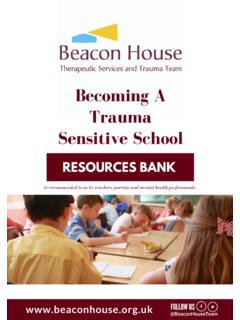

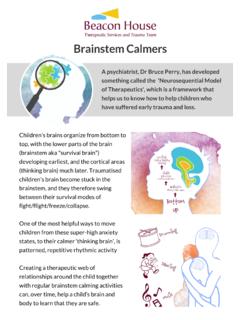

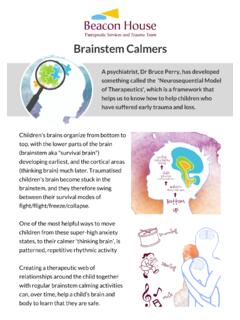

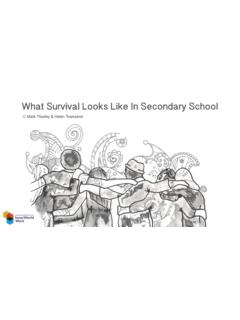

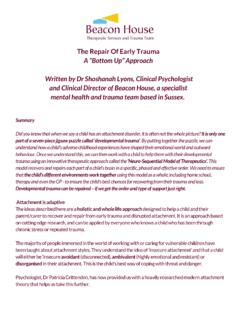
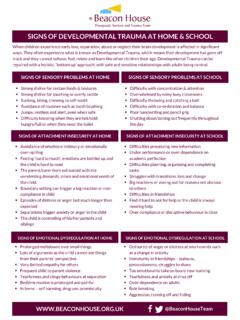

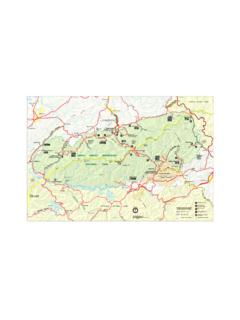
![Q¤k ¤n hCr] ©jh ¦J¨n©v ,«skIT r§ ¤p¥x v¤z t gª©JIvh j§ ©n ...](/cache/preview/3/0/1/2/6/9/5/c/thumb-3012695c8f12ec22ddf04f39b735b428.jpg)



